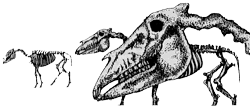 Hagerman Horse Quarry
Hagerman Horse Quarry
The Horse

Three and a half million years ago, also called the Pliocene Epoch, the area at Hagerman was a floodplain flowing into ancient Lake Idaho. Water supported an environment where pelicans, herons, swans, frogs and turtles lived. Grasslands supported animals such as the horse, camel and antelope.
The Hagerman horse is the earliest known representative of what would eventually become the animal we are familiar with today. It is believed that this horse was more closely related to Grevy's Zebra that now lives in Africa rather than to domestically bred horses.
It was about the same size as a modern day zebra, approximately 110-145 centimeters (43 to 57 inches) tall at the shoulder. It weighted between 110 and 385 kilograms (385 to 847 pounds).

Hagerman Horse (left), Grevy's Zebra (center), Modern
Thoroughbred (right)
Extinction
The Hagerman horse was only one stage in the continuing evolution of
horses. The animal continued to evolve on the North American continent until
the late Pliestocene period, about 10,000 years ago. Then, like camels, and
several other large bodied mammals that also existed in North America, they
vanished.
 The
cause of this mass extinction is unknown, and a number of theories exist.
Though many factors were probably involved, a dramatic fluctuation in climate
and perhaps the existence of prehistoric humans who may have relied upon these
animals as a food source may have played a part in their disappearance.
The
cause of this mass extinction is unknown, and a number of theories exist.
Though many factors were probably involved, a dramatic fluctuation in climate
and perhaps the existence of prehistoric humans who may have relied upon these
animals as a food source may have played a part in their disappearance.
Horses did not return to North America until the Spanish Conquistadors brought them from Europe in the late 1500's.
Scientific
Timeline*